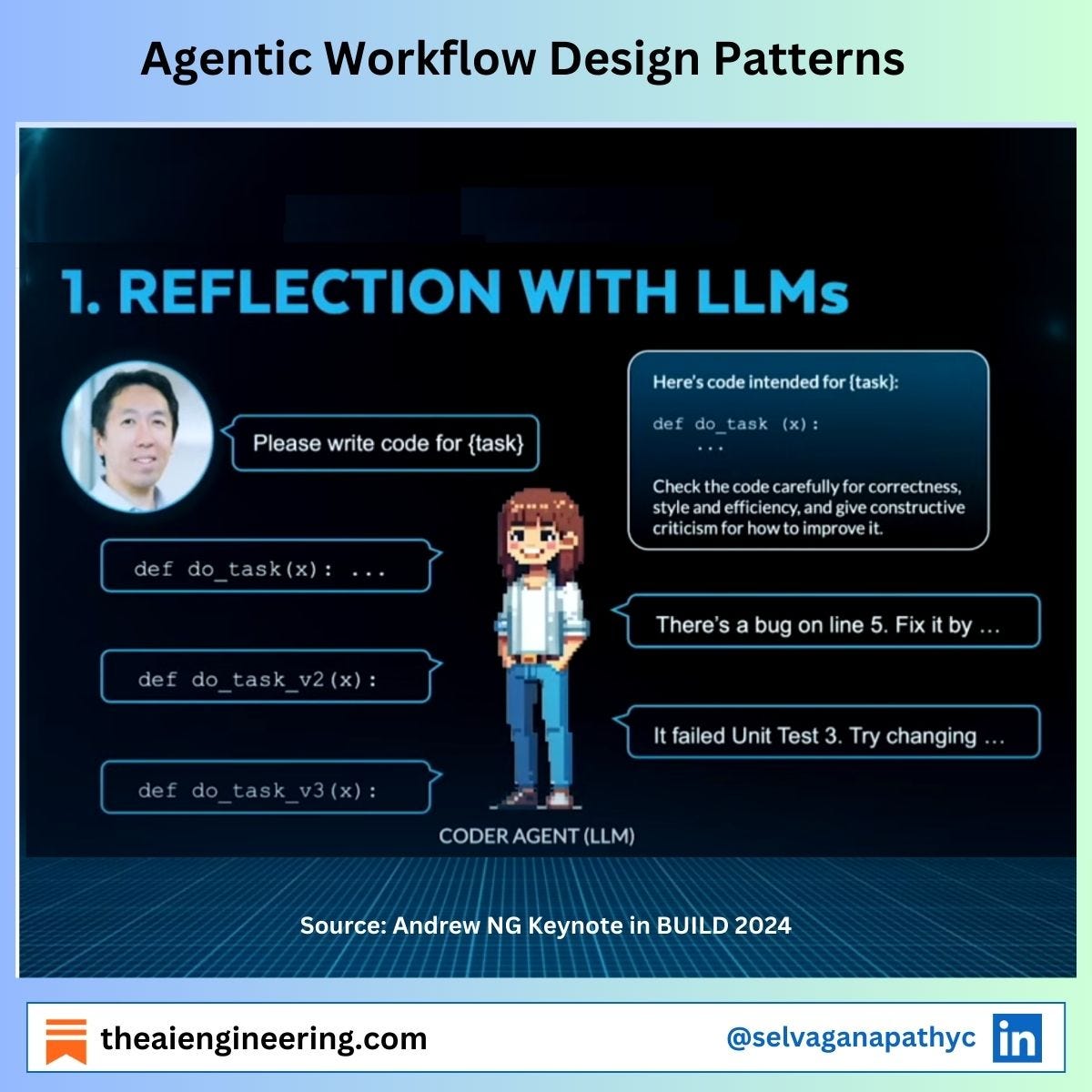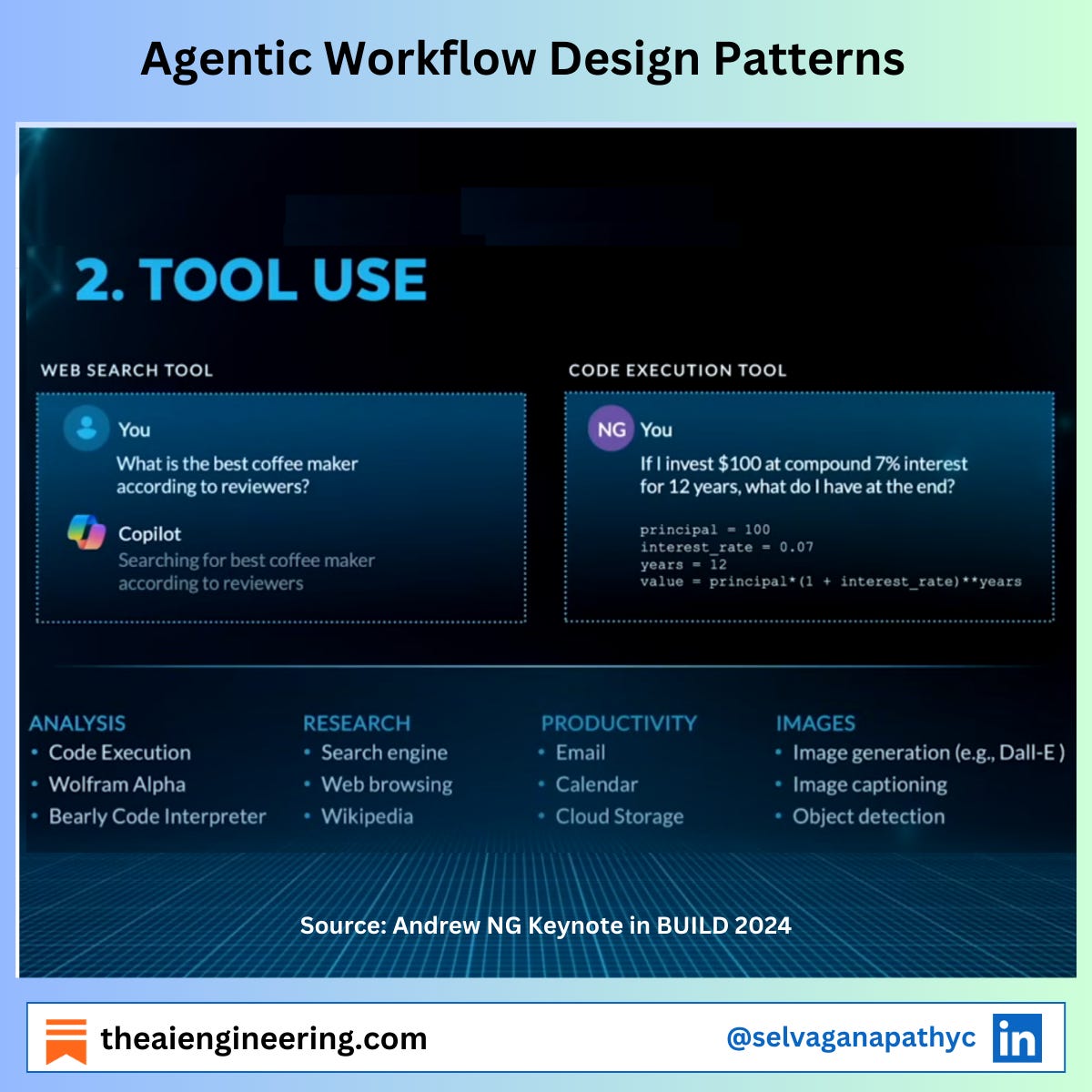In the rapidly evolving landscape of artificial intelligence, the concept of AI agents has emerged as a transformative approach to leveraging large language models (LLMs) for complex tasks. During his recent talk at Snowflake's BUILD 2024 Keynote, Andrew Ng outlined four fundamental design patterns that are shaping how we build effective agentic workflows.
These patterns aren't just theoretical frameworks—they represent practical approaches that developers and organizations are implementing today to enhance AI capabilities and deliver more sophisticated solutions. Let's explore each of these patterns in depth.
1. Reflection: The Self-Improving Loop
Perhaps one of the most powerful capabilities of modern LLMs is their ability to critique their own outputs. By implementing reflection, we prompt an AI system to:
Generate an initial solution or response
Evaluate that solution against specific criteria
Identify areas for improvement
Generate a refined solution based on this feedback
This creates a powerful iterative loop that mimics the human editing process. For example, when tasked with writing code, an LLM can first generate a solution, then "step back" to identify potential bugs, inefficiencies, or edge cases before producing an improved version.
The beauty of reflection lies in its simplicity and effectiveness. Without requiring additional tools or resources, it significantly enhances output quality through what is essentially a self-dialogue process.
2. Tool Use: Extending AI's Reach
While LLMs contain vast amounts of knowledge, they still have inherent limitations. The tool use pattern addresses these limitations by enabling AI systems to interact with external resources through API calls. This pattern allows LLMs to:
Retrieve real-time information via web searches
Execute code to perform calculations or data analysis
Access private or proprietary data sources
Interact with productivity applications (email, calendar, etc.)
Generate visual content or process images
By integrating with these external tools, AI systems transcend their role as purely conversational interfaces and become capable of taking concrete actions in the digital world. A well-implemented tool use pattern transforms an LLM from a knowledge repository into a proactive assistant that can bridge the gap between understanding and doing.
3. Planning (or Reasoning): The Strategic Approach
Complex problems rarely have straightforward solutions. The planning pattern addresses this reality by prompting LLMs to break down complex tasks into logical sequences of steps before attempting to solve them.
When implementing this pattern, we ask the AI to:
Analyze the overall objective
Identify key components and dependencies
Establish a sequential plan of action
Consider potential obstacles and alternative approaches
Execute the plan methodically
This approach mirrors how human experts tackle difficult problems—by thinking strategically before acting. For example, when asked to optimize a database query, an LLM using the planning pattern might first outline the steps: understand the current query structure, identify bottlenecks, consider indexing strategies, rewrite the query, and finally test performance improvements.
The planning pattern significantly enhances an AI's ability to handle multi-step problems that require structured thinking and helps avoid the pitfalls of rushing directly to solutions without adequate preparation.
4. Multi-Agent Collaboration: The Power of Specialization
Perhaps the most sophisticated pattern discussed by Andrew Ng is multi-agent collaboration. This approach involves creating multiple instances of LLMs (or the same LLM at different times) that play distinct roles in solving a problem.
In a multi-agent system, we might see:
A researcher agent that gathers information
A critic agent that evaluates proposals
A creative agent that generates novel solutions
A summarizer agent that consolidates findings
A coordinator agent that manages the overall workflow
This pattern leverages the power of specialization and diversity of perspective. By having different "experts" focus on specific aspects of a problem, the overall quality of the solution improves. This mimics successful human team structures where individuals with different strengths collaborate toward a common goal.
Multi-agent systems are particularly effective for complex tasks that benefit from multiple perspectives, such as content creation, strategic planning, or comprehensive research projects.
Combining Patterns for Maximum Impact
While each of these patterns is powerful on its own, the most sophisticated AI systems often combine multiple patterns to create robust workflows. For instance, a system might use planning to break down a complex task, tool use to gather necessary information, multi-agent collaboration to generate and critique solutions, and reflection to refine the final output.
As these design patterns mature and become more widely implemented, we're seeing the emergence of AI systems that can tackle increasingly complex, open-ended problems with greater autonomy and effectiveness.
Looking Ahead
The patterns outlined by Andrew Ng represent the current state of the art in agentic AI design, but this field is evolving rapidly. As LLMs continue to advance and new techniques emerge, we can expect these patterns to evolve and new ones to develop.
For developers and organizations looking to implement AI agents, understanding these fundamental patterns provides a valuable framework for designing effective systems. Rather than viewing AI as a monolithic solution, these patterns encourage us to think about the specific capabilities we want to enable and the most effective ways to structure AI workflows.
What's particularly exciting is that these patterns are accessible and implementable today. Whether you're building enterprise-grade AI solutions or experimenting with personal projects, these design patterns offer practical approaches to enhancing AI capabilities and delivering more value.






